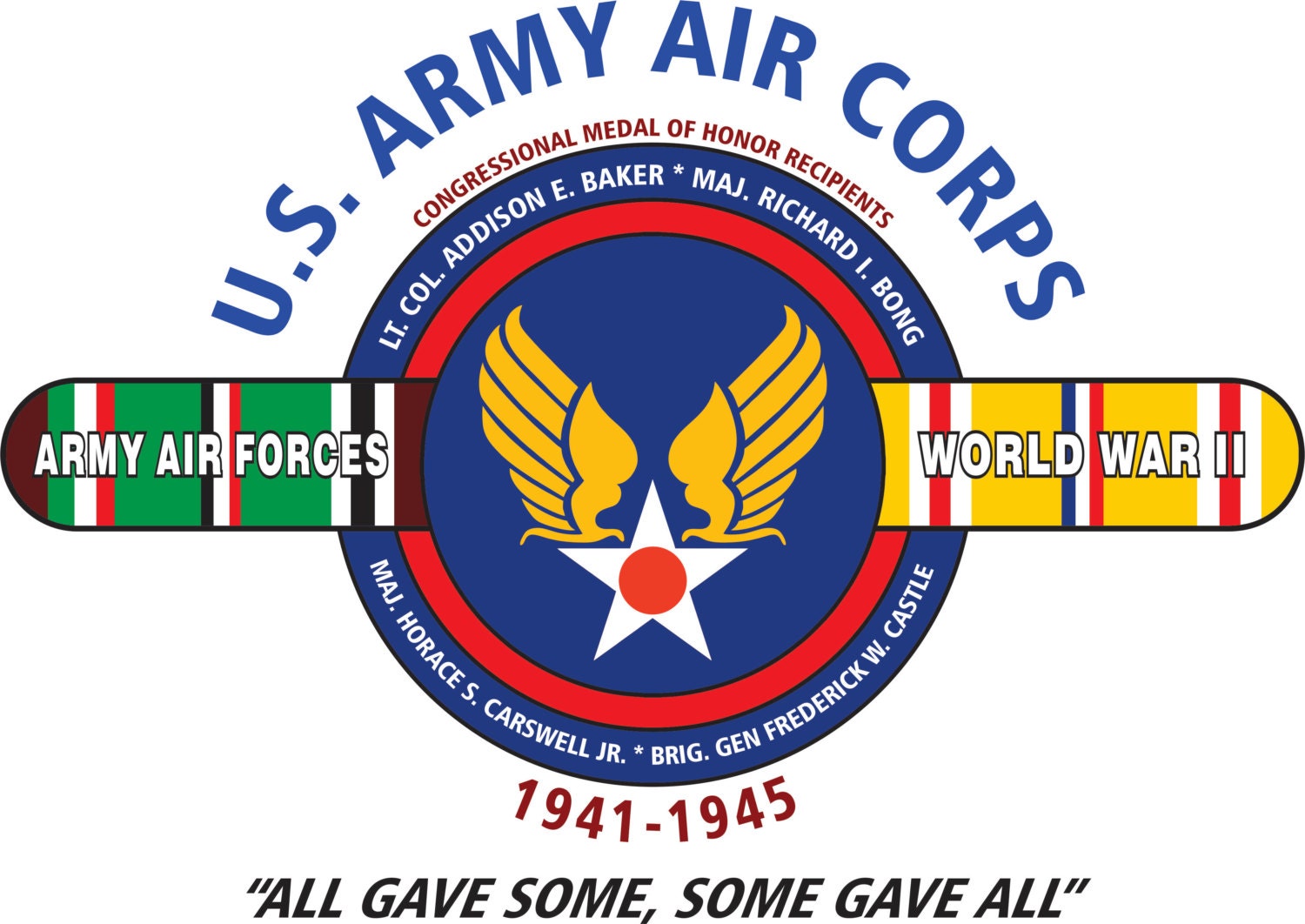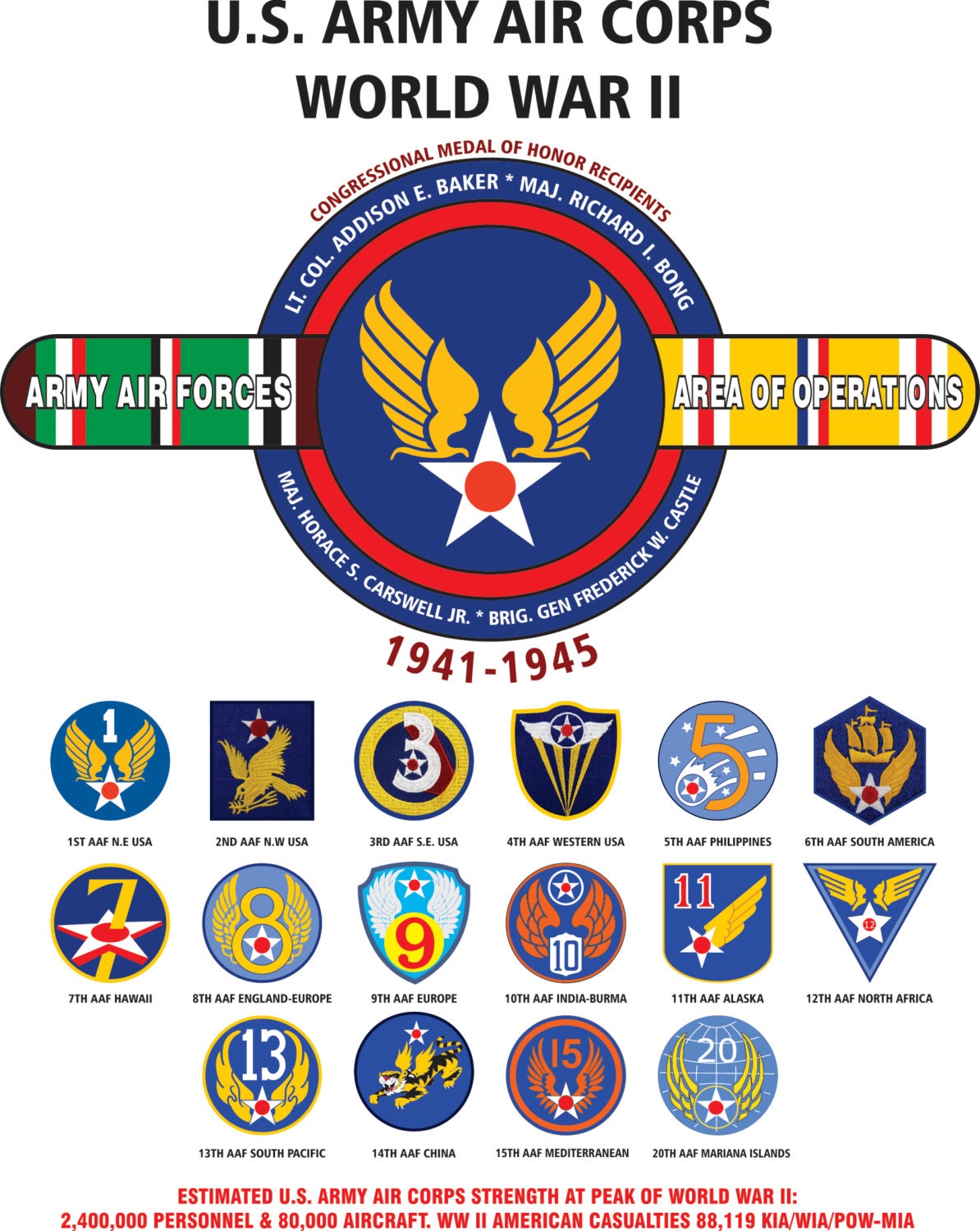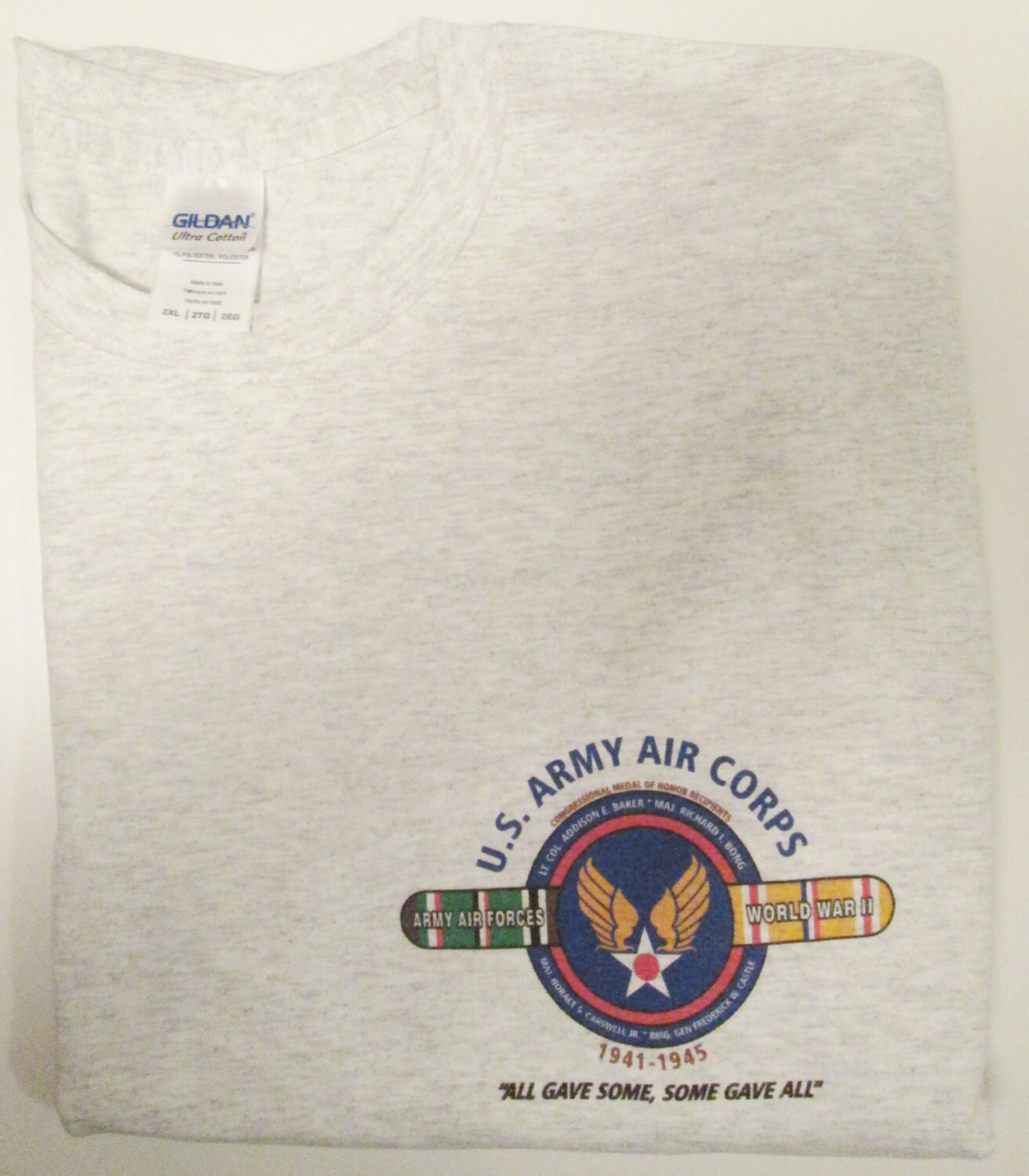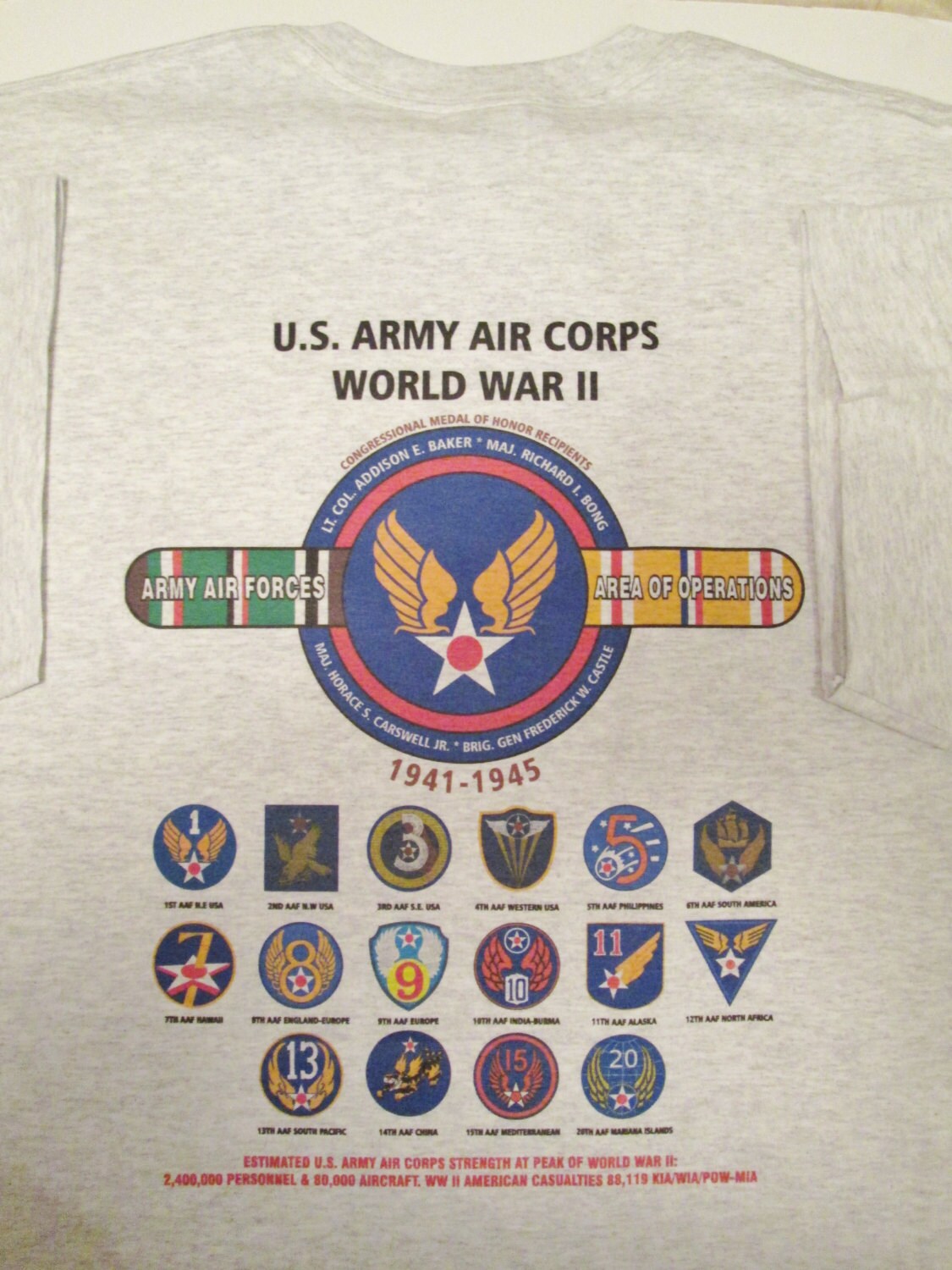U.S. Army Air Corps * Army Air Force Unit & Operations World War II 2-Sided Shirt
$35.95
U.S. Army Air Corps * Army Air Force Unit & Operations World War II 2-Sided Shirt
On 13 August 1941, the Air War Plans Division of the USAAF produced its plan for a global air strategy, AWPD/1.[99] Formally known as "Annex 2, Air Requirements" to "The Victory Program," a plan of strategic estimates involving the entire U.S. military,[100] the plan was prepared in accordance with strategic policies drawn earlier that year in the ABC-1 agreement with the British Commonwealth and the U.S. war plan Rainbow 5. Its forecast figures, despite planning errors from lack of accurate information about weather and the German economic commitment to the war, were within 2 percent of the units and 5.5 percent of the personnel ultimately mobilized,[101] and it accurately predicted the time frame when the invasion of Europe by the Allies would take place.[102]
AWPD/1 called for an air defense of the Western hemisphere, a strategic defense against Japan in the Pacific, and strategic bombardment by 6,800 bombers against Germany, identifying 154 key targets of the German economic infrastructure it considered vulnerable to a sustained campaign.[103] A strategic bomber requirement of 7,500 aircraft, which included the intercontinental B-36[103] (then still in the design phase), was far too large for American industry to achieve to be practical, and an interim plan to attack Germany with 3,800 bombers was included in AWPD/1.[103]
AWPD/1 was approved by Marshall and Secretary of War Henry Stimson in September 1941.[104] Although war began before the plan could be presented to Roosevelt, it became the foundation for establishing aircraft production and training requirements used during the war, and the concept of a strategic bomber offensive against Germany became policy of the U.S. government,[105] in accordance with United States strategic policy stated in Rainbow 5, as the only means available to the United States to take the war to Germany.[104]
In August 1942 Roosevelt called for a revision of proposed air requirements. AWPD/42 was presented on 6 September 1942, and although never accepted by the U.S. Navy, its revised estimates (which more than doubled production requirements to nearly 150,000 aircraft of all types, including those of the Navy and exports to allies) guided the Roosevelt Administration in 1943. The estimate was later reduced to 127,000, of which 80,000 were combat aircraft.
Like its predecessor, AWPD/42 laid out a strategic plan for the daylight bombing of Germany by unescorted heavy bombers, but also included a similar plan for attacks on Japan. Unfortunately the B-17 bomber command of the U.S. Eighth Air Force had only flown six relatively unopposed missions when AWPD/42 was drawn up, and the prior mistake in AWPD/1 of disregarding the need and feasibility of long-range fighter escorts was repeated.
Both plans called for the destruction of the German Air Force (GAF) as a necessary requirement before campaigns against priority economic targets. AWPD/1 established four target sets in order of priority: electrical power production, inland transportation, petroleum production, and Berlin;[95] while AWPD/42 revised the priorities, placing U-Boat facilities first, followed by transportation, electricity production, petroleum production, and rubber production.[96]
Operations summary[edit]
The Air Force Historical Studies Office summarizes the execution of USAAF strategy during World War II:[38]
"Arnold's staff made the first priority in the war to launch a strategic bombing offensive in support of the RAF against Germany. The Eighth Air Force, sent to England in 1942, took on that job. After a slow and often costly effort to bring the necessary strength to bear, joined in 1944 by the Fifteenth Air Force stationed in Italy, strategic bombing finally began to get results, and by the end of the war, the German economy had been dispersed and pounded to rubble.
"Tactical air forces supported the ground forces in the Mediterranean and European theaters, where the enemy found Allied air supremacy a constant frustration. In the war against Japan, General Douglas MacArthur made his advance along New Guinea by leap frogging his air forces forward and using amphibious forces to open up new bases. The AAF also supported Admiral Chester Nimitz's aircraft carriers in their island-hopping across the Central Pacific and assisted Allied forces in Burma and China.
"Arnold directly controlled the Twentieth Air Force, equipped with the new long-range B-29 Superfortresses used for bombing Japan's home islands, first from China and then from the Marianas. Devastated by fire-raids, Japan was so weakened by August 1945 that Arnold believed neither the atomic bomb nor the planned invasion would be necessary to win the war. The fact that AAF B-29s dropped the atomic bombs on Hiroshima and Nagasaki, nevertheless, demonstrated what air power could do in the future. The Strategic Bombing Survey provided ammunition for the leaders of the AAF in the postwar debates over armed forces unification and national strategy."
USAAF statistical summary[edit]
The United States Army Air Forces incurred 12% of the Army's 936,000 battle casualties in World War II. 88,119 airmen died in service. 52,173 were battle casualty deaths: 45,520 killed in action, 1,140 died of wounds, 3,603 were missing in action and declared dead, and 1,910 were non-hostile battle deaths. Of the United States military and naval services, only the Army Ground Forces suffered more battle deaths. 35,946 non-battle deaths included 25,844 in aircraft accidents, more than half of which occurred within the Continental United States.[106] 63,209 members of the USAAF were other battle casualties. 18,364 were wounded in action and required medical evacuation, and 41,057 became prisoners-of-war.[106][107] Its casualties were 5.1% of its strength, compared to 10% for the rest of the Army.[108][n 53]
Total aircraft losses for the AAF from December 1941 to August 1945 were 65,164, with 43,581 lost overseas and 21,583 within the Continental United States.[109] Combat losses of aircraft totaled 22,948 worldwide, with 18,418 lost in theaters fighting Germany and 4,530 lost in combat in the Pacific.[110] The AAF credited its own forces with destroying a total of 40,259 aircraft of opposing nations by all means, 29,916 against Germany and its allies and 10,343 in the Pacific.[111]
The cost of the war to the AAF was approximately $50 billion,[n 54] or about 30% of the cost to the War Department,[108] with cash expenditures from direct appropriations between July 1942 and August 1945 amounting to $35,185,548,000.[112]
Total sorties flown by the AAF during World War II were 2,352,800, with 1,693,565 flown in Europe-related areas and 669,235 flown in the Pacific and Far East.[113]
36 members of the Army Air Forces received the Medal of Honor for actions performed during air missions, 22 of them posthumously. Two additional awards were made, one posthumously, to AAF officers attached to the Western Task Force during Operation Torch.
Demobilization and independence[edit]
General Carl A. Spaatz
With the defeat of Japan, the entire United States military establishment immediately began a drastic demobilization, as it had at the end of World War I. The AAF was hit as hard or harder as the older services by demobilization. Officers and members were discharged, installations were closed, and aircraft were stored or sold. Between August 1945 and April 1946, its strength fell from 2.25 million men to just 485,000, and a year later to 304,000. Aircraft inventory dropped from 79,000 to less than 30,000, many of them in storage. Permanent installations were reduced from 783 to 177, just 21 more than pre-war.[114][115][n 55]
By July 1946, the Army Air Forces had only 2 combat-ready groups out of 52 that remained on the list of active units. A rebuilt air force of 70 groups, the authorized peacetime strength, was anticipated, with reserve and national guard forces to be available for active duty in an emergency. However considerable opposition to a large peacetime military establishment, and to the financial cost of such an establishment, resulted in planning cuts to 48 groups.
In February 1946, ill health forced the retirement of Arnold before he could fulfill his goal of achieving independence of the Air Force as a service equal with the Army and Navy. Spaatz replaced Arnold as the only other commanding general of the USAAF, and he oversaw both the demobilization of the largest air force in military history and its rebirth as envisioned by Mitchell and Arnold.
Arnold left the AAF with two important legacies, based on his experiences in World War II, which shaped the post-war USAAF and their independent successor. The first was a requirement that the command staff of the service must include staff officers of varying expertise besides pilots. The second was the belief that despite the unqualified success of training methods that had expanded the Air Forces, the United States would never again have the time to mobilize and train the reserve components as they had in 1940, necessitating that reservists and National Guardsmen be immediately ready for service in case of national emergency.[116]
For his part, Spaatz consulted closely with the new Army Chief of Staff, General Dwight D. Eisenhower, and reorganized the AAF into three major combat commands (Strategic Air Command, Tactical Air Command, and Air Defense Command)[n 56] that would not require a second restructuring once the Air Force became independent.[117] He also re-structured the reserve components to conform with Arnold's concepts, including creation of the Air National Guard in April 1946.[118]
In such a manner for the first time in the history of American aviation the Commander-in-Chief of the armed forces definitely took a stand in favor of an independent military air arm. Though far from providing the initial impulse, the President's message of 19 December 1945 contributed considerable impetus to a series of developments within the executive and legislative branches of the government which led directly, if belatedly, to the adoption of the National Security Act of 1947. —R. Earl McClendon, Autonomy of the Air Arm[119]
On 11 April 1945, at the conclusion of a ten-month study that took them to every major theater to interview 80 "key military and naval personnel," the Joint Chiefs of Staff Special Committee for the Reorganization of National Defense recommended that the armed forces of United States be organized into a single cabinet department, and that "three coordinate combat branches, Army, Navy, and Air" comprise the operational services. The committee reported that the statutory creation of a United States Air Force would merely recognize a situation that had evolved during World War II with the Army Air Forces, acknowledging that naval/marine aviation and some aspects of army aviation would remain in place. The committee also reported that its recommendation was approved by "Generals of the Army Douglas MacArthur and Dwight D. Eisenhower, Fleet Admirals Chester W. Nimitz and William F. Halsey and numerous other leading military and naval personnel."[120]
The Navy Department remained opposed to a single department of defense and, at the recommendation of the Chairman of the Senate Committee on Naval Affairs, created a panel using naval personnel to study the feasibility of a coordinating agency without executive powers as an alternative. The "Eberstadt report" made such a recommendation, but also endorsed the concept of an Air Force as a separate service. The Navy Department did not acknowledge its own findings and continued to oppose creation of a separate Air Force during hearings for unification bills introduced in October 1945. When the hearings failed to submit a report, President Harry S. Truman on 19 December 1945 came out strongly in support of an air force on a parity with ground and naval forces, reminding Congress that prior to the war independent Army and Navy Departments had often failed to work collectively or in coordination to the best interest of the nation. He asserted that wartime expedients that had overcome these defects proved to be the difference between victory and defeat.[120]
Congress, at the recommendation of Truman, created the Department of the Air Force in 1947. This legislation created the United States Air Force, a completely separate branch of the U.S. military. The transfer of personnel and assets was effected by Transfer Order 1, Office of the Secretary of Defense, 26 September 1947, implementing reorganization provisions of the National Security Act of 1947 (61 Stat. 495), 26 July 1947, and the Army Air Forces abolished.[121]
The initial delineation of service roles, Executive Order 9877, was supplanted on 21 April 1948, by the approval by Truman of the Key West Agreement, which outlined the air assets that each service would be permitted to maintain. The Air Force was assigned the bulk of strategic, tactical, and transport aircraft, but the issue remained divisive well into the 1950s.[122]
Legacy[edit]
The Army Air Forces in World War II, the official history of the AAF, summarized its significance as the final step to independence for the Air Force:
By the close of the war (the AAF) had emerged as virtually a third independent service. Officially, the AAF never became anything other than a subordinate agency of the War Department charged to organize, train, and equip air units for assignment to combat theaters. Its jurisdiction was wholly limited to the Zone of Interior, and it could communicate with air organizations in combat theaters only through channels extending up to the Chief of Staff, and then down through the theater commander to his subordinate air commander. The position of the AAF, in other words, was no different from that of the Army Ground Forces and the Army Service Forces, the other two of the three coordinate branches into which the Army had been divided. So, at any rate, read the regulations.
Actually, the Commanding General, Army Air Forces...functioned on a level parallel to that of the Chief of Staff...He moved at the very highest levels of command in the wartime coalition with Britain. He chose the commanders of the combat air forces...He communicated regularly (with the air commanders overseas)...He exerted a powerful influence on the development of strategy, tactics, and doctrine wherever AAF units fought...A world-wide system of air transport moved at his command through all theaters, (denying their) commanders their traditional prerogative of controlling everything within their area of responsibility. Throughout the war (he ran) the air war in whatever part of the world there seemed to be need for attention by Headquarters. The contrast between theory and fact is...fundamental to an understanding of the AAF.[3]
PSALM 91
THE SOLDIER, AIRMEN, MARINE & SAILORS PRAYER
1You who dwell in the shelter of the Most High,*
who abide in the shade of the Almighty,*
2Say to the LORD, “My refuge and fortress,
my God in whom I trust.”a
3He will rescue you from the fowler’s snare,
from the destroying plague,
4He will shelter you with his pinions,
and under his wings you may take refuge;b
his faithfulness is a protecting shield.
5You shall not fear the terror of the night
nor the arrow that flies by day,c
6Nor the pestilence that roams in darkness,
nor the plague that ravages at noon.d
7Though a thousand fall at your side,
ten thousand at your right hand,
near you it shall not come.
8You need simply watch;
the punishment of the wicked you will see.e
9Because you have the LORD for your refuge
and have made the Most High your stronghold,
10No evil shall befall you,
no affliction come near your tent.f
11*For he commands his angels with regard to you,g
to guard you wherever you go.h
12With their hands they shall support you,
lest you strike your foot against a stone.i
13You can tread upon the asp and the viper,
trample the lion and the dragon.j
II
14Because he clings to me I will deliver him;
because he knows my name I will set him on high.k
15He will call upon me and I will answer;l
I will be with him in distress;m
I will deliver him and give him honor.
16With length of days I will satisfy him,
and fill him with my saving power.n
* [Psalm 91] A prayer of someone who has taken refuge in the Lord, possibly within the Temple (Ps 91:1–2). The psalmist is confident that God’s presence will protect the people in every dangerous situation (Ps 91:3–13). The final verses are an oracle of salvation promising salvation to those who trust in God (Ps 91:14–16).
* [91:1] The shelter of the Most High: basically “hiding place” but in the Psalms a designation for the protected Temple precincts, cf. Ps 27:5; 31:21; 61:5. The shade of the Almighty: lit., “the shadow of the wings of the Almighty,” cf. Ps 17:8; 36:8; 57:2; 63:8. Ps 91:4 makes clear that the shadow is an image of the safety afforded by the outstretched wings of the cherubim in the holy of holies.
* [91:11–12] The words are cited in Lk 4:10–11; Mt 4:6, as Satan tempts Jesus in the desert.
a. [91:2] Ps 18:3; 31:3–4; 42:10; 142:6; 2 Sm 22:3.
b. [91:4] Ps 17:8; 36:8; 57:2; 63:8; Dt 32:11; Ru 2:12; Mt 23:37.
c. [91:5] Prv 3:25; Sg 3:8.
d. [91:6] Dt 32:24.
e. [91:8] Ps 92:12.
f. [91:10] Prv 12:21; Dt 7:15.
g. [91:11–12] Mt 4:6; Lk 4:10f.
h. [91:11] Heb 1:14.
i. [91:12] Ps 121:3; Prv 3:23.
j. [91:13] Is 11:8; Lk 10:19.
k. [91:14] Ps 9:11; 119:132.
l. [91:15] Jer 33:3; Zec 13:9.
m. [91:15] Is 43:2.
n. [91:16] Prv 3:2.
Shipping from United States
Processing time
1-3 business days
Customs and import taxes
Buyers are responsible for any customs and import taxes that may apply. I'm not responsible for delays due to customs.
Payment Options
Returns & Exchanges
I gladly accept exchanges and cancellations
Just contact me within: 14 days of delivery
Ship items back to me within: 21 days of delivery
Conditions of return
Buyers are responsible for return shipping costs. If the item is not returned in its original condition, the buyer is responsible for any loss in value.



